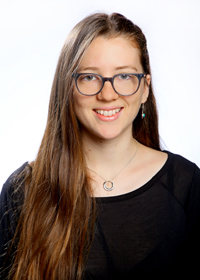Investigating Temporal Correlations in Atmospheric Seeing for the Large Synoptic Survey Telescope
Claire-Alice Hebert, Stanford University

Atmospheric turbulence significantly limits the performance of wide-field ground-based telescopes such as the Large Synoptic Survey Telescope (LSST). One of the LSST's scientific goals is to probe signatures of dark matter and dark energy by measuring shear, the subtle distortions of galaxy shapes due to weak gravitational lensing. This signal is hidden in spatial correlations of galaxy shapes, so for an unbiased measurement it is essential to correct for correlated noise, in particular the point-spread function (PSF), which describes image distortions due to telescope optics and the atmosphere.
Noise introduced by the atmosphere is the dominant contribution to the single-exposure LSST PSF and is highly spatially and temporally correlated due to wind blowing patches of turbulent air across the telescope aperture. It is often assumed that over long exposures these contributions will average out, so important questions concern the time scale of this averaging: How quickly does it happen? Is the asymptotic value zero? These questions are investigated using data from the Differential Speckle Survey Instrument (DSSI). These sets of short-exposure images of stars are in essence movies of the PSF that enable us to approximate PSF averaging in real data. We extract PSF parameters, e.g. size, and study their behavior as a function of exposure time.
Practicum: Given a spectrum from an unknown target, e.g. rock or soil, as measured via laser-induced breakdown spectroscopy (LIBS), the disaggregation of component chemical species is not currently solvable without computationally expensive, physics-based calculations. A fast surrogate method, which includes rigorous uncertainty quantification, could combine forward models and measured data. However, the large parameter space makes estimating the component species a difficult task. The approach here is to create fast single-compound emulators and combine them with well-chosen, expensive model runs for emulation of complex targets.
Abstract Author(s): Claire-Alice Hebert, Kary Myers, Bruce Macintosh, Patricia Burchat


